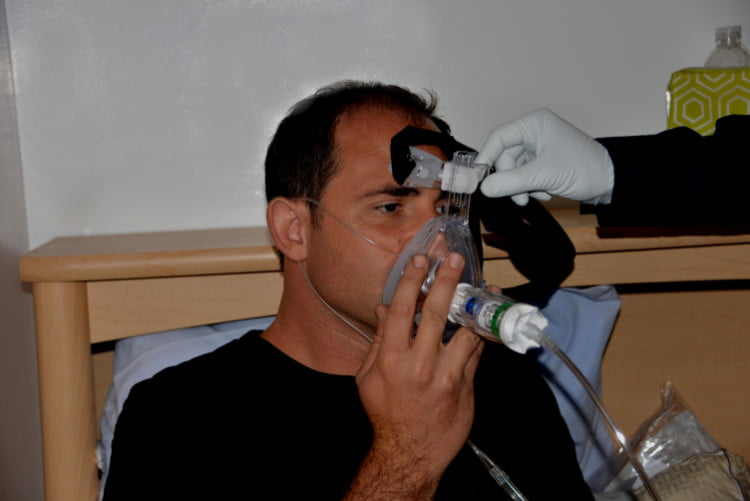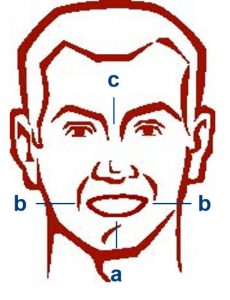
Photo by Rick McClure
Once you turn the CPAP device on, it becomes time to make your sales pitch.
Severe difficulty breathing, regardless of the cause, is an incredibly frightening experience for a patient. Your ability to quickly gain their confidence and reduce their fear is crucial to improving their respiratory status. The value of Continuous Positive Airway Pressure (CPAP) in treating acute dyspnea from a wide variety of conditions has led to widespread prehospital use.1 The scientific evidence clearly shows incredible benefits when CPAP is applied and outcomes continue to improve the earlier CPAP is applied.2-3 The art of selling CPAP to a patient, however, can make or break chances for success.
The continuous positive airway pressure generated by a CPAP device results from an extremely high flow of gas flow delivered into the upper airway. Generated by a venturi device, or drawn from a high-pressure outlet, gas flows into a CPAP mask can approach 100 liters per minute. Such flows are both loud and windy; certainly not the type of thing that would calm an already anxious patient.4 Add to that the claustrophobic effect of placing a mask over the face of an acutely short of breath patient and you can see the need for a good sales pitch.
Mask selection is critical for patient comfort, getting a good seal, avoiding eye irritation and preventing skin injury.5 A properly selected face mask borders three facial landmarks (see photo):

CPAP mask landmarks. Image courtesy of Respironics Inc.
- Below the lower lip (with the patients mouth open)
- The right and left corners of the patient’s mouth
- Just below the junction of the nasal bone and cartilage
Some CPAP systems come with sizing templates. With others, you may need to physically fit the mask on your patient. Regardless of manufacturer, it is wise to carry several sizes of masks. Once you have selected the proper size mask, you can place the headgear that will hold the mask in place. Once you turn the CPAP device on, it becomes time to make your sales pitch. Show the patient the mask and CPAP device; explain that it is loud and windy; assure them that it will markedly help to improve their breathing and do so quickly. Selling CPAP requires finesse – you need to be delicate but confident. Whenever possible, allow the patient to place the CPAP on themselves. Once they have had it in place for a few minutes, you can secure the mask with the previously placed headgear.
To help convince a patient that CPAP will help them, it is preferable to start at lower pressures (8 to 10 CWP) and then titrate upward once the mask is in place.2 It will, in all likelihood, require continued reassurance to convince the patient to continue use of CPAP until it’s effects become evident and you find the optimal pressure. In acute pulmonary edema, CPAP effects are immediate, usually seen within 20 seconds to a minute following application. Other acute respiratory conditions may require more time before the beneficial effects on breathing are experienced.
The final aspect of selling CPAP is knowing when to quit.2 Subjective findings that suggest CPAP is helping include a patient’s assessment of the level of their respiratory distress. Many clinicians use a Borg Scale, asking their patient to rate their respiratory distress on a scale of 0 to 10. Objective assessment findings include respiratory rate, capnography values and waveforms, work of breathing and oxygen saturation. Clinical practice guidelines suggest that a 20-minute trial of CPAP should provide enough time to determine whether it will help improve a patient’s respiratory status or if more aggressive therapies are warranted. It is probably unwise to use benzodiazepines or narcotics to reduce anxiety associated with CPAP. The drug classes decrease upper airway diameter and, although studies are limited, seem to lead to worse outcomes.6
The art of proper mask selection and good sales tactics, coupled with the science of continuous positive airway pressure, can help to improve outcomes for a wide variety of patients with acute respiratory distress. When combined with good assessment skills, you can instill confidence and trust in virtually any acutely dyspneic patient.
References:
- McEvoy M. The miracle of CPAP. JEMS.com. July 24, 2019. On-line: https://emsairway.com/2019/07/24/the-miracle-of-cpap/.
- Rochwerg B, Brochard L, Elliott MW, et al. Official ERS/ATS clinical practice guidelines: noninvasive ventilation for acute respiratory failure. Eur Respir J. 2017; 50.
- Bakke SA, Botker MT, Riddervold IS, et al. Continuous positive airway pressure and noninvasive ventilation in prehospital treatment of patients with acute respiratory failure: a systematic review of controlled studies. Scand J Trauma Resusc Emerg Med. 2014; 22:69.
- Cavaliere F, Conti G, Costa R, et al. Noise exposure during noninvasive ventilation with a helmet, a nasal mask, and a facial mask. Intensive Care Med 2004; 30:1755.
- Girault C, Briel A, Benichou J, et al. Interface strategy during noninvasive positive pressure ventilation for hypercapnic acute respiratory failure. Crit Care Med 2009; 37:124.
- Longrois D, Conti G, Mantz J, Faltlhauser A, Aantaa R, Tonner P. Sedation in non-invasive ventilation: do we know what to do (and why)? Multidiscip Respir Med. 2014;9:56.
Mike McEvoy, PhD, NRP, RN, CCRN, is the EMS coordinator for Saratoga County, New York, and the professional development coordinator for Clifton Park and Halfmoon Ambulance. He is a nurse clinician in the adult and pediatric cardiac surgery intensive care units at Albany Medical Center, where he also teaches critical care medicine. McEvoy is the chief medical officer and firefighter/paramedic for West Crescent Fire Department in Clifton, New York. He is also the chair of the EMS Section board of directors for the International Association of Fire Chiefs and a member of the New York State Governor’s EMS Advisory Council. He is a lead author of the textbook Critical Care Transport, the “Informed” Pocket References (Jones & Bartlett), and the American Academy of Pediatrics textbook Pediatric Education for Prehospital Professionals (PEPP).


